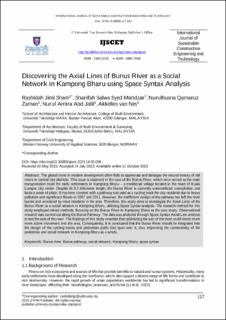| dc.contributor.author | Sham, Rashidah Jimi | |
| dc.contributor.author | Mahdzar, Sharifah Salwa Syed | |
| dc.contributor.author | Zaman, Nurulhusna Qamaruz | |
| dc.contributor.author | Jalil, Nurul Amira Abd | |
| dc.contributor.author | van Nes, Akkelies | |
| dc.date.accessioned | 2024-02-02T06:50:51Z | |
| dc.date.available | 2024-02-02T06:50:51Z | |
| dc.date.created | 2024-01-25T15:10:02Z | |
| dc.date.issued | 2023 | |
| dc.identifier.citation | International Journal of Sustainable Construction Engineering Technology (IJSCET). 2023, 14 (5), 117-130. | en_US |
| dc.identifier.issn | 2180-3242 | |
| dc.identifier.uri | https://hdl.handle.net/11250/3115155 | |
| dc.description | First published in International Journal of Sustainable Construction Engineering & Technology, vol. 14, no. 5 (2023). ISSN: 2180-3242, e-ISSN: 2600-7959 | en_US |
| dc.description.abstract | The global trend in modern development often fails to appreciate and damages the natural beauty of old rivers in central city districts. This issue is observed in the case of the Bunus River, which once served as the main transportation route for early settlements in Kampong Bharu – a traditional village located in the heart of Kuala Lumpur city center. Despite its 9.2-kilometer length, the Bunus River is currently underutilized, unexploited, and lacks a sense of place. It has been covered with a pathway and used as a cycling track for city residents due to heavy pollution and significant floods in 2007 and 2011. However, the inefficient design of the pathway has left the river buried and unnoticed by most residents in the area. Therefore, this study aims to investigate the Axial Lines of the Bunus River as a social network in Kampong Bharu, utilizing Space Syntax analysis. The research method for this study employed mixed methods, focusing on the Bunus River in Kampong Bharu as the case study. Observational research was carried out along the Bunus Pathway. The data was analyzed through Space Syntax Axial Line analysis to test the axis of the river. The findings of this study revealed that optimizing the axis of the river could direct much more active movement into the area. Consequently, it is concluded that the Bunus River should be integrated into the design of the cycling tracks and pedestrian paths that span over it, thus improving the connectivity of the pedestrian and social network in Kampong Bharu as a whole. | en_US |
| dc.language.iso | eng | en_US |
| dc.publisher | Universiti Tun Hussein Onn Malaysia | en_US |
| dc.rights | Navngivelse-Ikkekommersiell-DelPåSammeVilkår 4.0 Internasjonal | * |
| dc.rights.uri | http://creativecommons.org/licenses/by-nc-sa/4.0/deed.no | * |
| dc.title | Discovering the Axial Lines of Bunus River as a Social Network in Kampong Bharu using Space Syntax Analysis | en_US |
| dc.type | Peer reviewed | en_US |
| dc.type | Journal article | en_US |
| dc.description.version | publishedVersion | en_US |
| dc.rights.holder | Copyright (c) 2023 International Journal of Sustainable Construction Engineering and Technology | en_US |
| dc.source.pagenumber | 117-130 | en_US |
| dc.source.volume | 14 | en_US |
| dc.source.journal | International Journal of Sustainable Construction Engineering Technology (IJSCET) | en_US |
| dc.source.issue | 5 | en_US |
| dc.identifier.doi | 10.30880/ijscet.2023.14.05.009 | |
| dc.identifier.cristin | 2234590 | |
| cristin.ispublished | true | |
| cristin.fulltext | original | |
| cristin.qualitycode | 1 | |

